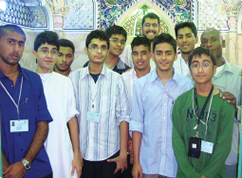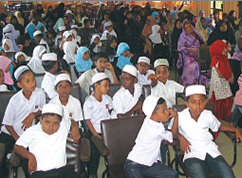Keep up to date with the Couples Retreat participants through these daily blogs.
Name: Ali ibn Hussain Zayn al-Abidin
Kunya: Imam al-Sajjad
Date & Place of Birth: 5 Sha’aban 38 AH, Medina
Father: Husayn ibn Ali
Mother: Lady Shahzanan
Date & Place of Martyrdom: Jannatul Baqi, Medina 25th Muharram 95 Hijri
The fourth Shia Imam, is narrated to have endured a battle of his own whilst the siege of his illness debilitated him completely. The son of Hussain (as), the valiant martyr of Karbala, had to endure the pain of not being physically able to aid his father in his fight against the tyrants.
The story of our fourth Imam begins with his early days. His youth and transition into adolescence concluded with him absorbing the mannerisms and the behavioural traits of his father and uncle. It is clear to us now that these crucial years are what prepared him for the ability to take over the Imamat on the plains of Karbala whilst his father gave him his final farewell.
In his feeble state and with his broken heart, he watched the heads of his loved ones paraded on the streets on top of spears, whilst him and the women of the family of Hussain (as) were taken as prisoners.
The aftermath of Karbala was such that after the women and children of the family of Hussain (as) were imprisoned by the army of Yazid, Yazid felt that the repercussions of holding the family any longer will result in loss of power so he ordered the family to be released immediately. Lady Zainab (sa) instructed Yazid that post-release, she wished to hold a majalis of commemoration in Shaam before returning to the plains of Karbala to mourn her beloved lost ones.
The fourth Imam, along with most of the women, later went to Madinah where they chose to reside. The next 35 years of his life, before he passed away, was a crucial time for his Imamat in this dunya. However, this proved extremely difficult because there was silence across the lands, no one uttered the name of Imam Hussain (as) without wishing certain death upon themselves. This is a crucial time in Imam’s life where he mastered the art of sabr (patience), for he knew that during these times he was unable to spread the message of Islam. It is narrated to us that during this period was when our fourth Imam gained the name “Imam Sajjad” with the latter meaning someone who remains in prostration. This name was a description of the endless days and nights our Imam would spend in the masjid of the Holy Prophet (saw), and it is these supplications that he would perform that, through the scribe of the Imam’s two sons, are given to us in a book commonly known as “Al Saheefa el Sajjadiya”.
Imam Sajjad (as) devoted his time towards helping the people of the city. It is narrated to us that he would leave the house in the darkness of the night with only God as his witness and distributed bread to the homeless and miskeen people of Madinah. This is a lesson within the art of charity that should resonate through the hearts of the givers within Islam, that there is an immense beauty that lies in those acts of charity whose identities are secret except to the Almighty.
After 35 years of peace in the life of the Imam (as) in Madinah silently spreading the divine message of Islam, whose rights were defended through the martyrdom of his father, the Umayyad ruler Al-Walid had the Imam poisoned after realising the success in Imam’s (as) mission as Imam. However, not only did the Imam (as) leave behind many prominent students such as the well known Abu Hamza-e-Thumali, but only after the demise of the Imam (as) did the beggars that he fed on streets in the night, learn about his identity. This served as a powerful fuel in the hearts of the believers after his passing.
Author: Mohammed Abbas Nasser
Main source:










